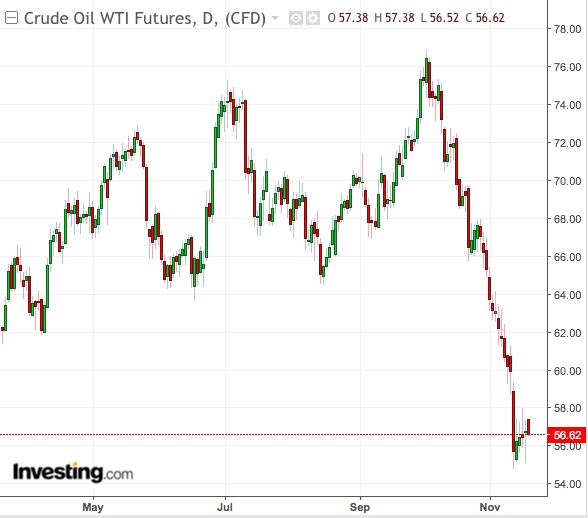It doesn’t matter whether Saudi Arabia announces a one-million-barrel cut when OPEC meets in December—or, for that matter, a two-million curb. What matters is whether the market will have faith in the oil-rich Kingdom to do as it says.
Indeed, that might be the Saudis’ real problem: a “trust deficit” since the summer, caused by a series of missteps on production versus pledges by the world’s largest crude exporter.
Once inclined to simply buy the party line coming out of Riyadh, oil traders are finding it a lot harder to do so when the prospect of a world swimming in oil from ramping US shale output appears more believable. As this analysis from a few weeks ago points out, the Saudi Energy Minister usually has the final word on oil, though, interestingly, the last time that didn’t hold true was during the shale-led 2014-2017 supply glut.
London-based Energy Aspects, known for insights into both the fundamentals and politics of energy trading, alluded in a note on Monday that the recent historical 12-day selloff in crude had as much to do with Saudi blundering as with US President Donald Trump’s weaker-than-expected sanctions on Iranian oil exports.
Saudi Arabia Is Undergoing A 'Crisis Of Confidence'
The agency wrote:
“Whether Saudi Arabia realizes it or not, there is a crisis of confidence over the Kingdom's policy. Saudi Arabia's commitment to stabilize inventories at or near the five-year average is being questioned and fears of 2014 are ringing all around, especially as US crude inventories are surging.”
When did this Saudi crisis of confidence begin? It began in June, when, at the behest of Trump, who had just announced the Iranian sanctions, Riyadh decided to end 18 months of production curbs that the Organization of the Petroleum Exporting Countries (OPEC) had coordinated with Russia. The so-called OPEC+ cuts were what reined in a three-year long oversupply and price collapse which brought crude to multiyear lows of nearly $25 a barrel in 2016.
Since June, however, Trump needed additional OPEC and Saudi output to put the brakes on an out-of-control oil rally triggered by the sanctions the US president planned to levy on Iran. Until then, the Middle Eastern country had exported a peak of 2.5 million barrels per day (bpd). Midterm elections in the US were approaching, and the president couldn’t afford to anger voters with high prices at the gasoline pump.
Publicly, Saudi Arabia’s Energy Minister Khalid al-Falih resisted Trump’s calls for additional supply, letting benchmark Brent soar to nearly $87 a barrel between May and October. But privately, the Kingdom’s heir and Trump ally Crown Prince Mohamad bin Salman, known as MbS, assured Washington that output would be raised as needed to compensate for the lost Iranian barrels. Complicit in this collaboration was Russia’s Energy Minister Alexander Novak, tacitly backed by his boss President Vladimir Putin.
The authority these three powers had on the oil market was spelled out in a Bloomberg opinion piece on Monday which said that Trump, MbS and Putin—and not OPEC—will determine the course of oil prices in 2019 and beyond.
Trio's Alliance Broken
The trio might have had the perfect alliance but then Trump approved generous waivers on the Iranian oil sanctions a day before the US midterm elections, after initially vowing to bring the Islamic Republic’s exports to zero. By then, the Saudis had begun pumping record volumes of oil. US shale output, lying low for nearly a year, also began ramping to all-time highs and millions of barrels of new stockpiles began piling up.

From a supply squeeze, suddenly the notion of oversupply took center stage. In just six weeks, crude prices lost 25 percent, more than they had gained in five months, and enduring a non-stop 12-day long selloff, the longest on record.
That triggered the second Saudi production policy reversal in under six months—this time to raise output.
But the Saudis had more surprises coming: another thinly-veiled warning from Trump that there should be no cuts, as well as Moscow’s disinclination to reduce production as Russian energy companies did not want to lose their market share. So, the Saudis announced their own initial cut of 0.5 million bpd, a paltry sum which the market responded to by selling off even harder. Then, within days, sources within the Kingdom murmured cuts of up to 1.4 million bpd when OPEC+ meets on December 6. With less than two weeks to that date, Russia remains non-committal.
Energy Aspects summed up the Saudi predicament:
“The task for OPEC on 6 December is simple, but we do not doubt for a second that OPEC and Russia will make it complicated.”
The agency added:
“The market has almost completely given up on the bullish narrative, as it simply does not know if the Saudis can deliver on their promises or how the relationship with the US will evolve given the cloud hanging over MbS.”
Market Mayhem … And Politics
That “cloud” is none other than the persistent belief that MbS ordered the murder of his critic, the Saudi-born journalist and US resident Jamal Khashoggi. A CIA investigation apparently concluded the crown prince ordered the hit, despite denials from the Kingdom. The Trump administration has so far issued some low-level sanctions against Saudi nationals, but should a direct link to MbS emerge, it might lead to a more significant and embarrassing outcome for Riyadh.
Phil Flynn, oil analyst at Chicago’s Price Futures Group notes the irony that a, "CIA report could have an impact on oil prices.”
Energy Aspects concluded:
“The complicated US-Saudi relationship right now means that the market cannot be certain that Saudi Arabia is able to act on fundamentals alone. No one can be certain that Trump will not force MbS to back down the night before the OPEC meeting.”
